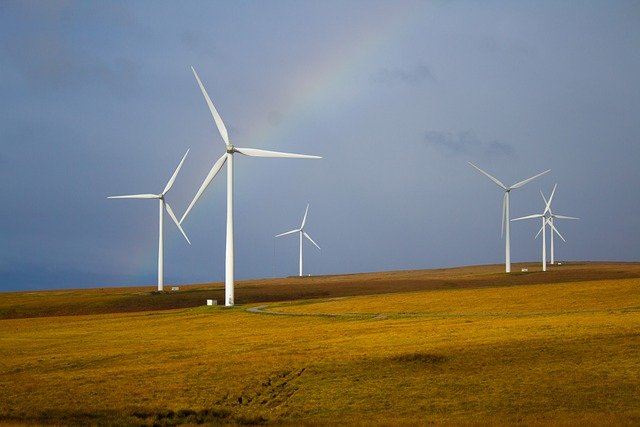Ten Point Plan for a Green Industrial Revolution will create and support up to 250,000 British jobs

BIGGEST EVER RENEWABLE ENERGY SUPPORT SCHEME OPENS
The biggest ever round of the UK Government’s flagship renewable energy support scheme is opening to applications today (Monday, 13 December), with £285 million available a year for building the next generation of Great Britain’s green energy projects.
Renewable energy projects across Great Britain can now bid for funding in the fourth round of the Contracts for Difference (CfD) scheme, which is aiming to secure 12GW of electricity capacity – more renewable capacity than the previous three rounds combined. The additional offshore wind capacity resulting from the funding alone could generate enough electricity to power around 8 million homes.
Compared to the previous round, this is open to an expanded number of renewable energy technologies, with offshore wind, onshore wind, solar, tidal and floating offshore wind projects, amongst others, all eligible to bid for funding in the scheme’s auction process – this will ensure we have a more secure, more resilient energy system and support the UK’s transition to net zero through a greater range of energy sources.
There has also been a strengthening of the supply chain plan process, so the CfD’s fourth round can support the effective development of open and competitive supply chains and promote innovation and skills in the low-carbon electricity generation sector.
The £20 million per year support for tidal stream projects represents the biggest investment into tidal power in a generation, kickstarting a brand-new chapter for the tidal industry that could also have the benefit of creating jobs across the UK.
Business and Energy Secretary Kwasi Kwarteng said:
“Our biggest ever renewables auction opening today will solidify the UK’s role as a world-leader in renewable electricity, while backing new, future-proof industries across the country to create new jobs.
“By generating more renewable energy in the UK, we can ensure greater energy independence by moving away from volatile global fossil fuel prices, all while driving down the cost of new energy.”
A total budget of £285 million a year has been allocated to the fourth round, with £200 million available for offshore wind, £75 million for emerging technologies, such as remote island wind, tidal stream and floating offshore wind, and £10 million for established technologies, such as solar and onshore wind.
Within emerging technologies, £24 million a year has been ringfenced for floating offshore wind projects and £20 million initially set aside for tidal stream projects, demonstrating the government’s support for new, innovative technologies that can make an important contribution to the UK’s decarbonisation commitments.
Subject to the outcome of the competitive auction, it is expected that AR4 will be a major step towards delivering the government’s increased ambition to have 40GW of offshore wind by 2030, including 1GW to come from floating offshore wind, as set out in the Ten Point Plan for a Green Industrial Revolution.
Energy and Climate Change Minister Greg Hands said:
“The Contracts for Difference scheme is proof that green and growth go hand-in-hand as it continues to be a key driver behind the world-leading renewable energy sector that is providing us with secure clean energy, creating jobs across the UK and opening investment and export opportunities.
“The previous three rounds have allowed us to push forward with the Green Industrial Revolution and this round will take us further and faster than ever before while continuing to drive down costs for consumers.”
RenewableUK CEO Dan McGrail said:
“This is set to be a landmark auction securing the largest amount of new renewable energy capacity so far, as Ministers have listened to our calls for the overall capacity cap to be lifted to reflect the enormous appetite among companies and investors in UK projects.
“More than 16GW of wind could be ready to compete and over 23GW of renewables overall. We could see investment of over £20bn in this round, creating thousands of jobs and cutting costs for energy consumers.
“We need a range of renewable technologies to get us to net zero as fast as possible, so it’s great to see the development of innovative floating wind and tidal stream projects supported by ring-fenced funding, as we’ve been advocating. This will enable us to ramp up the roll-out of these cutting-edge technologies, building up massive industrial opportunities for the future, including exports.”
Low Carbon Contracts Company CEO Neil McDermott, said:
“We’ve been supporting new low-carbon power projects through the CfD scheme since its inception, so we’re incredibly excited to see what the next Allocation Round brings. The current CfD portfolio features projects located across the length and breadth of Great Britain, including some of the world’s largest offshore wind farms to date.
“We’ve seen the scheme’s impact on diversifying and increasing the investment needed to support vital new low-carbon power, and this year’s COP26 only served to underline the critical timing of this round.
“We’ve learned a fantastic amount to date and we stand ready to support the ambitious infrastructure that will power the UK’s transition to Net Zero emissions by 2050, as well as protecting the long-term health of our environment, economies and societies.”
Green industrial revolution in sight as government sets out plans for more clean energy
24th Nov 2020: The government has today (24 Nov) set out its next steps towards a green industrial revolution with ambitious plans for the next round of its flagship renewables support scheme.
The fourth round of the Contracts for Difference (CfD) scheme – to open in late 2021 – will aim to double the capacity of renewable energy compared to the last round and expand the number of technologies supported, with offshore wind, onshore wind, solar, tidal and floating offshore wind projects all eligible to bid.
This will be coupled with a new consultation looking at the supply chain and ways to support more jobs and private investment by increasing the competitiveness of UK manufacturers. It will mean the country can reap the rewards of clean energy following the Prime Minister’s Ten Point Plan for a Green Industrial Revolution published last week.
Energy Minister Kwasi Kwarteng said:
“The UK is a world leader in clean energy, with over a third of our electricity now coming from renewables. That huge achievement is thanks to the government’s Contracts for Difference scheme.
“The new plans set out today build on the Prime Minister’s Ten Point Plan and put us firmly on the path towards building a new, green industrial revolution.”
Prime Minister Boris Johnson’s Ten Point Plan for a Green Industrial Revolution for 250,000 jobs
The Prime Minister last week (18 Nov) set out his ambitious ten point plan for a green industrial revolution which will create and support up to 250,000 British jobs.
Covering clean energy, transport, nature and innovative technologies, the Prime Minister’s blueprint will allow the UK to forge ahead with eradicating its contribution to climate change by 2050, particularly crucial in the run up to the COP26 climate summit in Glasgow next year.
The plan – which is part of the PM’s mission to level up across the country – will mobilise £12 billion of government investment, with £4 billion to create and support up to 250,000 highly-skilled green jobs in the UK, and spur over three times as much private sector investment by 2030.
At the centre of his blueprint are the UK’s industrial heartlands, including in the North East, Yorkshire and the Humber, West Midlands, Scotland and Wales, which will drive forward the green industrial revolution and build green jobs and industries of the future.
Prime Minister Boris Johnson said:
“Although this year has taken a very different path to the one we expected, I haven’t lost sight of our ambitious plans to level up across the country. My Ten Point Plan will create, support and protect hundreds of thousands of green jobs, whilst making strides towards net zero by 2050.
“Our green industrial revolution will be powered by the wind turbines of Scotland and the North East, propelled by the electric vehicles made in the Midlands and advanced by the latest technologies developed in Wales, so we can look ahead to a more prosperous, greener future.”
Ten Point Plan for a Green Industrial Revolution
The Prime Minister’s ten points, which are built around the UK’s strengths, are:
- Offshore wind: Producing enough offshore wind to power every home, quadrupling how much we produce to 40GW by 2030, supporting up to 60,000 jobs.
- Hydrogen: Working with industry aiming to generate 5GW of low carbon hydrogen production capacity by 2030 for industry, transport, power and homes, and aiming to develop the first town heated entirely by hydrogen by the end of the decade.
- Nuclear: Advancing nuclear as a clean energy source, across large scale nuclear and developing the next generation of small and advanced reactors, which could support 10,000 jobs.
- Electric vehicles: Backing our world-leading car manufacturing bases including in the West Midlands, North East and North Wales to accelerate the transition to electric vehicles, and transforming our national infrastructure to better support electric vehicles.
- Public transport, cycling and walking: Making cycling and walking more attractive ways to travel and investing in zero-emission public transport of the future.
- Jet Zero and greener maritime: Supporting difficult-to-decarbonise industries to become greener through research projects for zero-emission planes and ships.
- Homes and public buildings: Making our homes, schools and hospitals greener, warmer and more energy efficient, whilst creating 50,000 jobs by 2030, and a target to install 600,000 heat pumps every year by 2028.
- Carbon capture: Becoming a world-leader in technology to capture and store harmful emissions away from the atmosphere, with a target to remove 10MT of carbon dioxide by 2030, equivalent to all emissions of the industrial Humber today.
- Nature: Protecting and restoring our natural environment, planting 30,000 hectares of trees every year, whilst creating and retaining thousands of jobs.
- Innovation and finance: Developing the cutting-edge technologies needed to reach these new energy ambitions and make the City of London the global centre of green finance.
To deliver on six points of the plan, the Prime Minister announced new investment, including:
Carbon capture: To revitalise the birthplaces of the first industrial revolution, the UK will be at the global forefront of carbon capture, usage and storage technology, benefiting regions with industries that are particularly difficult to decarbonise.
An extra £200 million of new funding to create two carbon capture clusters by the mid-2020s, with another two set to be created by 2030. This increased the total invested to £1 billion, helping to support 50,000 jobs, potentially in areas such as the Humber, Teesside, Merseyside, Grangemouth and Port Talbot.
Hydrogen: Up to £500 million, including for trialling homes using hydrogen for heating and cooking, starting with a Hydrogen Neighbourhood in 2023, moving to a Hydrogen Village by 2025, with an aim for a Hydrogen Town – equivalent to tens of thousands of homes – before the end of the decade. Of this funding, £240 million will go into new hydrogen production facilities.
Nuclear: £525 million to help develop large and smaller-scale nuclear plants, and research and develop new advanced modular reactors.
Electric vehicles: Following extensive consultation with car manufacturers and sellers, the Prime Minister has confirmed that the UK will end the sale of new petrol and diesel cars and vans by 2030, ten years earlier than planned. However we will allow the sale of hybrid cars and vans that can drive a significant distance with no carbon coming out of the tailpipe until 2035.
The UK car industry already manufactures a significant proportion of electric vehicles in Europe, including one of the most popular models in the world.
To support this acceleration, the Prime Minister announced:
- £1.3 billion to accelerate the rollout of chargepoints for electric vehicles in homes, streets and on motorways across England, so people can more easily and conveniently charge their cars.
- £582 million in grants for those buying zero or ultra-low emission vehicles to make them cheaper to buy and incentivise more people to make the transition.
- Nearly £500 million to be spent in the next four years for the development and mass-scale production of electric vehicle batteries, as part of our commitment to provide up to £1 billion, boosting international investment into our strong manufacturing bases including in the Midlands and North East.
This will help protect and create thousands of new jobs, particularly in the Midlands, North East, and North Wales.
We will also launch a consultation on the phase out of new diesel HGVs to put the UK in the vanguard of zero emission freight. No date has been set yet.
Homes and public buildings: £1 billion next year into making new and existing homes and public buildings more efficient, extending the Green Homes Grant voucher scheme by a year and making public sector buildings greener and cutting bills for hospitals and schools, as part of the Public Sector Decarbonisation Scheme.
Greener maritime: £20 million for a competition to develop clean maritime technology, such as feasibility studies on key sites, including Orkney and Teesside.
This follows ambitious plans to make the UK the world leader in clean wind energy, and plans for greater protections for England’s iconic landscapes and the creation of new national parks, as set out by the Prime Minister over the last few weeks.
Other key parts of the plan will be driven forward by significant investment set out over the last year, including the £1 billion energy innovation fund to stay ahead of the latest technologies needed to reach new energy targets, £5 billion for alternative greener ways of travel including cycling, walking, and buses, and £5.2 billion to create for new flood and coastal defences in England by 2027.
These new commitments backed by government funding send a clear signal to industries across the British economy to invest in the UK, which is why the Prime Minister hosted a virtual roundtable with green investors to set out his ambitious plan and incentivise further private sector investment.
This marks the beginning of the UK’s path to net zero, with further plans to reduce emissions whilst creating jobs to follow over the next year in the run up to the international COP26 climate summit in Glasgow next year.
The CfD scheme is the government’s primary method of supporting low-carbon electricity. It encourages investment in renewable energy by providing projects with a stable income, while protecting consumers from paying increased costs when electricity prices are high.
The fourth round aims to increase the capacity of renewable energy from the 5.8GW achieved in the last round to up to 12GW, which could be enough to power 20 million electric cars on the UK’s roads in any year.
Government support to unleash the potential of offshore wind generation has seen the cost of it fall by two thirds in the last 5 years. Given its long-term potential to support the country’s 2050 net zero target, offshore wind projects will compete in their own ‘pot’ in the next auction process rather than against other technologies as they have previously.
Last year’s third round delivered record-low prices and secured enough clean energy to power over 7 million homes. Today’s plans set out changes to the structure of the scheme to build on that success.
Floating offshore wind projects will be able to bid for contracts for the first time, allowing wind farms to be built further away from the shoreline where it is windiest and increasing the UK’s renewable energy capacity even further.
And as announced in March, solar and onshore wind projects will be able to bid for the first time since 2015, coupled with a commitment to update guidance for new onshore wind schemes in England to fully reflect the impacts and benefits to local communities.
Following the first consultation on the fourth CfD round, the government has also announced today (24 November 2020) that a second consultation is being launched on new proposals for the Supply Chain Plan.
The proposals are designed to increase the clarity, ambition and measurability of commitments made by renewable project developers when they bid for contracts in the CfD scheme, and to introduce new measures if they subsequently fail to deliver on those commitments.
Today’s announcement follows last week’s unveiling of the Prime Minister’s Ten Point Plan, which outlines an ambitious vision of a low-carbon future for the UK, and will ensure that clean energy continues to play a key role in ending our contribution to climate change entirely by 2050.
The fourth round will see three ‘pots’ for renewables technologies:
- Pot 1: Established technologies – including onshore wind and solar PV
- Pot 2: Less-established technologies – including floating offshore wind, Advanced Conversion Technologies and tidal stream
- Pot 3: Offshore wind
Former coal-burning power stations that have been converted to biomass generation will be excluded from future CfD rounds
Contracts for Difference are 15-year private law contracts between renewable electricity generators and the Low Carbon Contracts Company (LCCC), a government-owned company that manages CfDs at arm’s length from government
contracts are awarded in a series of competitive auctions, known as allocation rounds, which have been run every 2 years. In the auction process, the lowest price bids are successful, which drives efficiency and cost reduction
CfDs give greater certainty and stability of revenues to electricity generators by reducing their exposure to volatile wholesale prices, while protecting consumers from paying for higher costs when electricity prices are high
the scheme has delivered substantial new investment and helped deliver significant reductions in the costs of capital for some renewable technologies
the third round of the CfD renewable energy auction delivered record-low prices on enough clean energy to power over 7 million homes
in the fourth allocation round of CfD, the government’s aim is to support up to double the capacity of renewable energy from levels achieved in the third round, rising from 5.8GW in AR3 to up to 12GW in AR4
following the conclusion of the third CfD Allocation Round in September 2019, the scheme currently supports 49 renewable electricity projects (73 CfDs) across a range of technologies, totalling around 15.5 GW











Responses